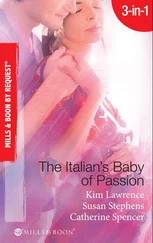He glanced over at Katerina and said, “Looks like our choices are limited. We’ll start with her.”
“Jasna, though, doesn’t know all ten secrets the Madonna has passed to the others,” the guide was saying at the front of the bus, and Michener’s attention returned to what the woman was explaining.
“All five of the others know the ten secrets. It is said that when all six are told, the visions will end and a visible sign of the Virgin’s presence will be left for atheists. But the faithful must not wait for that sign before they convert. Now is the time of grace. A time for deepening faith. A time for conversion. Because, when the sign comes, it will be too late for many. Those are the Virgin’s words. A prediction for our future.”
“What do we do now?” Katrina whispered in his ear.
“I say we still go see her. If for nothing else, I’m curious. She can certainly answer the thousand questions I have.”
Outside, the guide motioned to Apparition Hill.
“This is where the first visions occurred to the original two seers in June 1981—a brilliant ball of light in which stood a beautiful woman holding a baby. The next evening, the two children returned with four of their friends and the woman appeared again, this time wearing a crown of twelve stars and a pearl-gray dress. She seemed, according to them, clothed by the sun.”
The guide pointed to a steep footpath that led from the village of Podbrdo to a site where a cross stood. Even now, pilgrims were making the climb beneath thick clouds rolling in from the sea.
Cross Mountain appeared a few moments later, rising less than a mile from Medjugorje, its rounded peak standing more than sixteen hundred feet high.
“The cross atop was erected in the 1930s by the local parish and carries no significance to the apparitions, except many pilgrims have reported seeing luminous signs in and around it. Because of that, this spot has become part of the experience. Try to make a trip to the top.”
The bus slowed and entered Medjugorje. The village was unlike the multitude of other undeveloped communities they’d passed along the way from Split. Low stone buildings in varied shades of pink, green, and ocher gave way to taller buildings—hotels, the guide explained, recently opened to handle an influx of pilgrims, along with duty-free shops, car rental agencies, and travel bureaus. Shiny Mercedes taxis skirted among transport trucks.
The bus stopped at the twin towered Church of St. James. A placard out front announced that Mass was said throughout the day in a variety of languages. A concrete piazza spanned the front, and the guide explained that the open expanse was a gathering spot at night for the faithful. Michener wondered about tonight, though, since thunder rumbled in the distance.
Soldiers patrolled the square.
“They are part of the Spanish peacekeeping forces assigned to the region and can be helpful,” the guide explained.
They gathered their shoulder bags and left the bus. Michener approached the guide. “Excuse me, where could we find Jasna?”
The woman pointed down one of the streets. “She lives in a house about four blocks in that direction. But she comes to the church each day at three, and sometimes in the evening for prayer. She will be here shortly.”
“And the apparitions, where do they occur?”
“Most times here in church. That’s why she comes. I must tell you, it’s unlikely she would see you unannounced.”
He got the message. Probably every pilgrim wanted an encounter with one of the seers. The guide motioned toward a visitor center across the street.
“They can arrange for a meeting. Those usually take place later in the afternoon. Talk to them about Jasna. You’ll get more of a response. They’re sensitive to your needs.”
He thanked her, then he and Katerina walked off. “We have to start somewhere, and this Jasna is the closest. I don’t particularly want to talk with a group present, and I don’t have any needs that require sensitivity. So let’s go find this woman ourselves.”
THIRTY-NINE
VATICAN CITY, 2:00 P.M.
The procession of cardinals made their way out of the Pauline Chapel, singing refrains from Veni Creator Spiritus. Their hands were clasped in prayer, their heads lowered. Valendrea kept pace behind Maurice Ngovi as the camerlengo led the group toward the Sistine Chapel.
All was ready. Valendrea himself had supervised one of the last chores an hour earlier when the House of Gammarelli arrived with five boxes containing white linen cassocks, red silk slippers, rochets, mozzettas, cotton stockings, and skullcaps in varying sizes, all with the backs and hems unsewn, the sleeves unfinished. Any adjustments would be made by Gammarelli himself, just before the cardinal chosen pope first appeared on the balcony of St. Peter’s.
On the pretense of inspecting everything, Valendrea had made sure there was a set of vestments—42 to 44 in the chest, 38 in the waist, size 10 slippers—which would require only a few modifications. After, he would have Gammarelli fashion an assortment of traditional white linen outfits, along with a few new designs he’d been mulling over for the past couple of years. He intended to be one of the best-dressed popes in history.
One hundred and thirteen cardinals had made the trip to Rome. Each of the men was attired in a scarlet cassock with a mozzetta encircling his shoulders. They wore red birettas and gold and silver pectoral crosses above their breasts. As they inched forward in a single-file line toward a towering doorway, television cameras captured the scene for billions around the world. Valendrea noticed the grave faces. Perhaps the cardinals were taking heed of Ngovi’s sermon at the noon Mass when the camerlengo urged each of them to leave worldly considerations outside the Sistine and, with the help of the Holy Spirit, choose a capable pastor for the mother Church.
That word pastor was a problem. Rarely had a twentieth-century pope been pastoral. Most were career intellectuals or Vatican diplomats. Pastoral experience had been talked about over the past few days in the press as something the Sacred College should look for. Certainly a pastoral cardinal, one who’d spent his career working with the faithful, carried a stronger appeal than a professional bureaucrat. He’d even heard, on the tapes, how many of the cardinals mused that a pope who knew how to run a diocese would be a plus. Unfortunately, he was a product of the Curia, a born administrator, possessed of no pastoral experience—unlike Ngovi, who rose from missionary priest to archbishop to cardinal. He resented the camerlengo’s earlier reference and took the comment as a jab at his candidacy—a subtle poke, but more evidence Ngovi could become a formidable opponent in the hours ahead.
The procession stopped outside the Sistine Chapel.
A choir echoed from inside.
Ngovi hesitated at the doors, then started forward.
Photographs portrayed the Sistine as a huge expanse, but it was actually a difficult place in which to accommodate 113 cardinals. It had been built five hundred years ago to be the pope’s private chapel, its walls framed in elegant pilasters and covered in narrative frescoes. On the left was the life of Moses, on the right the life of Christ. One set Israel free, the other the entire human race. The Creation on the ceiling expressed man’s destiny, then foresaw an inevitable fall. The Last Judgment above the altar was a terrifying vision of divine wrath, one Valendrea had long admired.
Two rows of raised platforms flanked the center aisle. Name cards delineated who sat where, the spots allocated by seniority. Chairs were straight-backed, and Valendrea did not cherish the prospect of sitting in one for long. Before each chair, on a tiny desk, sat a pencil, a pad of paper, and a single ballot.
Читать дальше












